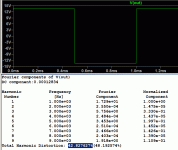Hello,
Checking some Power Amps, the one that I like the t.amp E-400 – Thomann Lithuania. Can I find better one than this? Is this thing actually have 190Wrms @ 4ohm?
Checking some Power Amps, the one that I like the t.amp E-400 – Thomann Lithuania. Can I find better one than this? Is this thing actually have 190Wrms @ 4ohm?
Looks like it does use a fan (forced air cooling) - see attached image....unless it has a fan.
-Gnobuddy
Attachments
Actually this is a better deal at 159 euros the t.amp E-800 – Thomann Lithuania. Was looking at manual and I found that "Limiter" is an option to limit THD at 5%. However I found that in manual at 50% output power @ 8R it does less then < 0.03%. So how come is that even possible to have 5% THD if at half power is 0.03%?
This one has variable switch between 0.7Vinput and 1.4Vinput. If I have DSP that does 0.9Voutput I have to use 0.7Vinput or 1.4Vinput on amp?
This one has variable switch between 0.7Vinput and 1.4Vinput. If I have DSP that does 0.9Voutput I have to use 0.7Vinput or 1.4Vinput on amp?
Last edited:
All modern solid-state power amps have very, very low distortion over almost the entire range of power output, from zero output up to some maximum. Above that, the amp runs out of capability because the signal starts to clip, and distortion climbs very, very rapidly, until it reaches 100% THD (pure square wave).So how come is that even possible to have 5% THD if at half power is 0.03%?
It is up to the human operating the amp to keep it from clipping - lower the volume just a little, add a compressor, add a limiter, do something intelligent to prevent the harsh clipping and enormous distortion.
Going by specs, use the 0.7V input; this means you have more than enough gain to get all the way to full power.If I have DSP that does 0.9Voutput I have to use 0.7Vinput or 1.4Vinput on amp?
But also try the 1.4V input. You will have to turn the volume knob a little higher to get the same volume as before. You may find this actually makes it easier to control the volume, so try it and see.
You will not damage the amp by choosing the wrong input, by the way; just remember to start with the volume at zero, before selecting either input, and then raise the volume smoothly from there until you reach whatever loudness you intend. (And don't let it clip!)
-Gnobuddy
...100% THD (pure square wave)....
Just for our information:
A hard square wave seems to be about 42.827627% THD. (Maybe 42.749279%)
Attachments
Last edited:
Here's my reasoning for the 100% THD figure:A hard square wave seems to be about 42.827627% THD. (Maybe 42.749279%)
1) A sine wave has an RMS value of 1/(square root of 2) of its peak value.
2) A square wave has an RMS value equal to its peak value. (This can be verified graphically or by doing the integral, or here: https://www.google.com/url?sa=t&rct...ntation.docx&usg=AOvVaw2lxRT6XyAx0Yvj-X8YrlvI )
3) Since power to a resistive load is proportional to the square of the RMS amplitude, item (2) means that a square wave delivers twice as much power to its load as a same-amplitude sine wave.
4) Item (3) implies that if we run an amplifier up to full sinewave power, and then proceed to overdrive it until it clips all the way into a square, we double the output power (assuming a perfect amp with zero output impedance and a perfectly regulated power supply.)
5) Going from sine to square is done by the addition of harmonics of the sine. Therefore, 50% of the power in the square wave is in the harmonics, and 50% in the fundamental (sine).
6) The definition of total harmonic distortion is (sum of the powers in all harmonics)/(power in the fundamental) x 100.
7) From step 5, this yields 100% THD for the square wave.
Maybe there's a mistake in my reasoning. Or maybe this is a case where the missing 67% THD in your simulation is contained in an infinite number of infinitely smaller and smaller harmonics, which is missed by the numerical simulation, but included in my analytical calculation.
I suspect the latter, since the Fourier series for a square wave has coefficients that fall very slowly with increasing order, going as 1/(2n+1), where n = 0,1,2,3,4.... and so on. In other words, there is still appreciable power contained even in high-order harmonics.
It would be interesting to see the output of an old-fashioned analogue THD meter (which notches out the fundamental frequency, leaving only the harmonics).
There is probably a way to calculate the THD analytically since we know the Fourier coefficients of a square wave ( https://www.stewartcalculus.com/data/CALCULUS Early Transcendentals/upfiles/FourierSeries5ET.pdf ). It basically comes down to squaring and summing that 1/(2n+1) series, first including all the sine terms, and second, including all terms but the first.
I'm not sure my brain is awake enough to tackle that tonight, but it might be possible - if we're lucky, it'll turn out to just be a case of summing an infinite geometric or harmonic series.
P.S. In the real world no square-wave is truly square, and we don't care much about the power in the 100th harmonic...so PRR's approach of finding the THD in only the first ten harmonics is probably more realistic in a practical sense.
-Gnobuddy
I didn't go 10 harmonics and I'm sure that makes little difference.
The harmonic level falls with order. Even-order should not appear in a square wave.
The un-normalized numbers:
1 = 17.3
3 = 5.7
5 = 3.5
7 = 2.5
rms(5.7+3.5+2.5) is 7.
Ratio 17.3:7 is 0.41
Adding some more harmonics adds the last couple %.
> clips all the way into a square, we double the output power
Ah. Makes sense on the face of it. I have an early appointment so I'll leave it here.
There ARE alternate ways ("ambiguity") to compute THD. Mostly when you need to cheat.
Total harmonic distortion - Wikipedia
The harmonic level falls with order. Even-order should not appear in a square wave.
The un-normalized numbers:
1 = 17.3
3 = 5.7
5 = 3.5
7 = 2.5
rms(5.7+3.5+2.5) is 7.
Ratio 17.3:7 is 0.41
Adding some more harmonics adds the last couple %.
> clips all the way into a square, we double the output power
Ah. Makes sense on the face of it. I have an early appointment so I'll leave it here.
There ARE alternate ways ("ambiguity") to compute THD. Mostly when you need to cheat.
Total harmonic distortion - Wikipedia
And that link contains the sentence "A pure square wave with infinite harmonics has THDF of 48.3%,[1][13][14]..."
The first of those references is available online, and proved to be readable, at least initially; I was able to follow the calculation of THD for a square wave, and it is {square root of ( ((pi^2)/8) - 1 )}, which works out to 48.3%.
So you are correct, and my estimate is badly wrong.
I think I found the mistake I was making: I calculated THD for a square wave and sine wave of the same peak value, visualizing an amp gradually driven from clean into clipping.
But if you take the Fourier series of a square wave, the amplitude of the fundamental is not the same as the amplitude of the square wave...it's bigger! (And so, THD is lower.)
This leads to something I didn't expect at all: if you feed an amplifier a sinewave, and gradually turn up the amplitude till clipping starts, and then push it further into clipping, the amplitude of that fundamental-frequency sinewave continues to increase!
-Gnobuddy
You posted that while I was composing my last post...I think we both found the error I was making at about the same time.The value of the fundamental of a square wave is not 1.0 but 1.27. That does not cover the discrepancy, but reminds up that wave-smacking is not a simple thing.
-Gnobuddy
And that link contains the sentence "... THDF of 48.3%..."
I didn't *read* my own citation! Thanks for spotting that.
> fundamental-frequency sinewave continues to increase!
Intuitively: if you tune your ear to just the 1kHz, and crank past clipping, the 1kHz *does* increase. Yes, that's not normal hearing: the harmonics cloud perception, and we are used to just hearing "louder" without reference to the fundamental. I would not trust my ears either way (blind or knowing). Band-filter meter would tell; so could a tuned pipe (snip of garden-hose) on an SPL meter.
me> reminds up that wave-smacking
Sorry, "...reminds us that wave-smacking..."
What about Behringher A800 (2 x 400W @ 4ohms) which is a fanless Class-D reference studio amplifier available between 170-180€ ?Hello,
Checking some Power Amps, the one that I like the t.amp E-400 – Thomann Lithuania. Can I find better one than this? Is this thing actually have 190Wrms @ 4ohm?
- Status
- This old topic is closed. If you want to reopen this topic, contact a moderator using the "Report Post" button.
- Home
- Live Sound
- Instruments and Amps
- Power Amplifier [150Euros]

